Menu: Home | Tours | Art Show | Events | Shippen Manor | Shippen Manor News | Art Grants | History | Directions / Contact
The museum’s season is the 1st and 2nd Sundays, May to December. Hours depending upon the programming scheduled for that day. Please visit Warren200.com for our museum programming schedule.
The building was originally constructed in four parts: c. 1754, 1780s/90s, mid-19th c., and post-1800. We have five rooms open for tours.
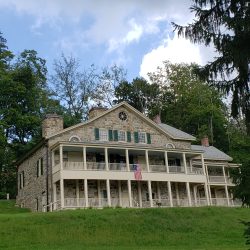
Robeson Study: This is a part of the oldest part of the building (south side), an original “2 x 2 block house”, and is interpreted as the iron master’s study as it is closest to the Furnace. In this room are artifacts that represent our varying industrial histories– mining, furnace, railroad, etc. The first porch from Belvidere Ave. (along the upper drive) is the main entrance for visitors. Please knock and wait for a greeter to open the door as all of our doors open from the inside out.
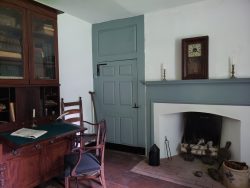
Reception Room: This room served a variety of functions throughout the Manor’s 270 years– general room, dining room, and even a 20th c. kitchen. It is a part of the 2nd addition (Reception, Dining, upstairs and basement rooms).This room is decorated to reflect the colonial era as this is a part of the 2nd addition (after the Revolutionary War). Artifacts here are from around the county as well as archaeological items from the 1990s surveys at the Manor. In the fireplace is an original fireback that was produced at our historic Furnace in the mid-18th c. The second porch from Belvidere Ave. is the ADA accessible entrance as well as our exit. (Doors only open from the inside. If you need assistance entering the museum and need to use this entrance, please knock and wait for assistance.)
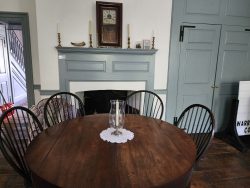
Family Dining Room: This room is interpreted as the “Family Dining Room”, but it may have served other uses. The doorway from the Reception Room is not original and used to be where the closet is in the Reception Room. The mural (c. 2004) reflects the bucolic agrarian life during the 18th and 19th c. In the fireplace is a replica fireback. The furniture is from the 18th c.
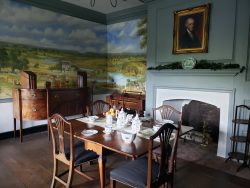
Family Kitchen: Until 1800, this room served as the family’s kitchen. It has a large stone hearth and a brick beehive oven. This room was used as a kitchen until 1800, then the hearth was sealed and the room turned into a bedroom (remaining that way until the 1970s!). Additionally, there are both artifacts and replicas from the 18th c. era.
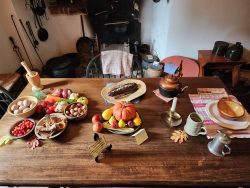
Victorian Parlor: This room, originally divided into two rooms by a fireplace wall, reflects the Henry-Scranton-Valentine eras (1830s to 1920s). Inside this room are artifacts that belonged to the Scrantons that were believed to be in the Manor during their era, in addition to local artifacts from Washington. Here you will see woodcarvings from David Bibinger, a wood carver who worked in the Washington organ factories, as well as the Cornish family bible, and an assortment of 19th c. photographs, drawings, paintings, prints, most of which were donated by relatives of the Henry-Scranton families. Additionally, there are images of Mrs. Fowler (widowed cousin of the Scrantons who was in charge of the building when was it was a boarding house around the 1860s-1880s), and the Valentine family (Empire Steel & Iron, 1911-1924). We are in the process of adding to the families of the 20th c. in our interpretation. The room is decorated as one, but has two themes– one side for the gentlemen and the other for the ladies.
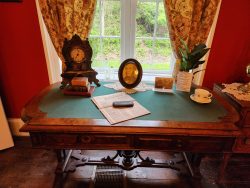
The addition on the far north side is a part of the offices of Cultural & Heritage Affairs, which are not open for tours. It is believed that after the hearth in the family kitchen was sealed in 1800 the summer kitchen (north addition) was then used. Today, the hearth is gone and the only remnant is the bump-out on the north side of the building, which was the beehive oven. When the 3rd addition was added (Victorian Parlor), it was connected to the north addition, making it one building. The masonry is seamless, making it difficult to determine from the outside where the additions connected.
Our upper driveway was a part of the Warren Railroad, and was a main line until the Van Nest Gap/Oxford Tunnel was built in the mid-19th c. The white marble tunnel marker (Van Nest Gap/Oxford) was removed from the tunnel 30+ years ago and later installed in our wall for safe keeping. There are no tunnels under this property or from our basement to the furnace or down to modern Route 31.
For special events and programming, the lower museum rooms may be open to the public and they are accessible from the east side (lower driveway/porch). They comprise of the “Workers’ Kitchen” and the speakers’ room. We will have speakers (“Shippen Talks”) who will use this room, as well as our docent who does “On the Daily” a few times during the season. It is not open regularly.
We ask that all visitors refrain from walking or sitting on our walls (dry stacked or mortared) and parking where cones are present (location of delicate historical remnants).
As this site is a part of the Warren County Parks/Open Space, visitors are permitted on the grounds daily during daylight hours. After the sun has set, the site is closed to the public.
Shippen Manor does not participate in paranormal investigations. Our focus is on the history, education and preservation.
